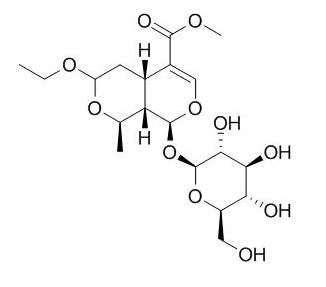7-O-ethyl-morroniside
7-O-ethyl-morroniside is a natural product from Lonicera morrowii.
Inquire / Order:
manager@chemfaces.com
Technical Inquiries:
service@chemfaces.com
Tel:
+86-27-84237783
Fax:
+86-27-84254680
Address:
1 Building, No. 83, CheCheng Rd., Wuhan Economic and Technological Development Zone, Wuhan, Hubei 430056, PRC
Providing storage is as stated on the product vial and the vial is kept tightly sealed, the product can be stored for up to
24 months(2-8C).
Wherever possible, you should prepare and use solutions on the same day. However, if you need to make up stock solutions in advance, we recommend that you store the solution as aliquots in tightly sealed vials at -20C. Generally, these will be useable for up to two weeks. Before use, and prior to opening the vial we recommend that you allow your product to equilibrate to room temperature for at least 1 hour.
Need more advice on solubility, usage and handling? Please email to: service@chemfaces.com
The packaging of the product may have turned upside down during transportation, resulting in the natural compounds adhering to the neck or cap of the vial. take the vial out of its packaging and gently shake to let the compounds fall to the bottom of the vial. for liquid products, centrifuge at 200-500 RPM to gather the liquid at the bottom of the vial. try to avoid loss or contamination during handling.
Int J Mol Sci.2020, 21(6):2190.
BMC Complement Med Ther.2023, 23(1):264.
Pharm Biol.2016, 54(7):1255-62
Front Pharmacol.2020, 11:683.
Sichuan Agricultural University2023, 4630743.
Chem Pharm Bull (Tokyo).2017, 65(9):826-832
Heliyon.2023, e12778.
Sci Rep. 2018, 462(8)
Food Chem X.2024, 24:101794.
Front Pharmacol.2021, 12:690113.
Related and Featured Products
J Chromatogr A. 2017 Jun 30;1504:1-8.
Water-compatible micron-sized monodisperse molecularly imprinted beads for selective extraction of five iridoid glycosides from Cornus officinalis fructus.[Pubmed:
28511931]
An efficient, accurate and sensitive method for the determination of five iridoid glycosides (IGs) in Cornus officinalis fructus using molecularly imprinted solid phase extraction (MISPE) coupled with high performance liquid chromatography (HPLC) has been developed.
METHODS AND RESULTS:
Water-compatible molecularly imprinted beads (MIBs) were synthesized by precipitation polymerization, using alkenyl glycosides glucose as the hydrophilic functional monomer. Scanning electron microscopy showed that the MIBs had a narrow particle size distribution, with diameters in the range 7.5-9.3μm. The special molecular recognition by the MIBs of IGs in aqueous media was verified by static adsorption, kinetic adsorption, and selectivity experiments. The newly prepared MIBs were used as sorbents in solid phase extraction (SPE) for the selective recognition of five IGs (loganin, morroniside, loganic acid, 7-O-ethyl-morroniside and 7-O-methyl morroniside) in Cornus officinalis fructus. When optimized, the MISPE-HPLC method had good linearity (0.02-100mgg-1), with correlation coefficient (R)≥0.994. Recoveries at three spiked levels were in the range 80.0%-94.0%.
CONCLUSIONS:
Because of its excellent specificity and hydrophilicity, SPE based on monodisperse MIBs provides a promising pretreatment strategy for the analysis of active components in natural products, especially for the quality control of traditional Chinese medicines.
Zhong Yao Cai. 2011 Feb;34(2):218-20.
Studies on the chemical constituents from stems and leaves of Lonicera macranthoides.[Pubmed:
21823476]
To research the chemical constituents from stems and leaves of Lonicera macranthoides.
METHODS AND RESULTS:
Various column chromatographies were employed to isolate and purify the constituents. Their structures were elucidated by spectral analysis (IR, MS, 1H-NMR, 13 C-NMR) and chemical evidence.
Nine constituents were obtained and identified as loganin (I), loganic acid (II), morroniside (III),7-O-ethyl-morroniside (IV), scopoletin (V), caffeic acid (VI), chlorogenic acid (VII), beta-sitosterol (VIII), daucosterol (IX).
CONCLUSIONS:
Compounds I-VI are isolated from the plant for the first time. All the compounds are found for the first time from the stems and leaves of Lonicera macranthoides.



